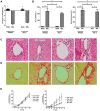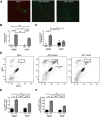Probiotics Improve Inflammation-Associated Sickness Behavior by Altering Communication between the Peripheral Immune System and the Brain
- PMID: 26224864
- PMCID: PMC6605112
- DOI: 10.1523/JNEUROSCI.0575-15.2015
Probiotics Improve Inflammation-Associated Sickness Behavior by Altering Communication between the Peripheral Immune System and the Brain
Abstract
Patients with systemic inflammatory diseases (e.g., rheumatoid arthritis, inflammatory bowel disease, chronic liver disease) commonly develop debilitating symptoms (i.e., sickness behaviors) that arise from changes in brain function. The microbiota-gut-brain axis alters brain function and probiotic ingestion can influence behavior. However, how probiotics do this remains unclear. We have previously described a novel periphery-to-brain communication pathway in the setting of peripheral organ inflammation whereby monocytes are recruited to the brain in response to systemic TNF-α signaling, leading to microglial activation and subsequently driving sickness behavior development. Therefore, we investigated whether probiotic ingestion (i.e., probiotic mixture VSL#3) alters this periphery-to-brain communication pathway, thereby reducing subsequent sickness behavior development. Using a well characterized mouse model of liver inflammation, we now show that probiotic (VSL#3) treatment attenuates sickness behavior development in mice with liver inflammation without affecting disease severity, gut microbiota composition, or gut permeability. Attenuation of sickness behavior development was associated with reductions in microglial activation and cerebral monocyte infiltration. These events were paralleled by changes in markers of systemic immune activation, including decreased circulating TNF-α levels. Our observations highlight a novel pathway through which probiotics mediate cerebral changes and alter behavior. These findings allow for the potential development of novel therapeutic interventions targeted at the gut microbiome to treat inflammation-associated sickness behaviors in patients with systemic inflammatory diseases.
Significance statement: This research shows that probiotics, when eaten, can improve the abnormal behaviors (including social withdrawal and immobility) that are commonly associated with inflammation. Probiotics are able to cause this effect within the body by changing how the immune system signals the brain to alter brain function. These findings broaden our understanding of how probiotics may beneficially affect brain function in the context of inflammation occurring within the body and may open potential new therapeutic alternatives for the treatment of these alterations in behavior that can greatly affect patient quality of life.
Keywords: TNF-alpha; cerebral intravital microscopy; microglia; monocytes.
Copyright © 2015 the authors 0270-6474/15/3510822-10$15.00/0.
Figures






Similar articles
-
Interactions Between Platelets and Inflammatory Monocytes Affect Sickness Behavior in Mice With Liver Inflammation.Gastroenterology. 2017 Nov;153(5):1416-1428.e2. doi: 10.1053/j.gastro.2017.08.011. Epub 2017 Aug 9. Gastroenterology. 2017. PMID: 28802564
-
Liver-brain interactions in inflammatory liver diseases: implications for fatigue and mood disorders.Brain Behav Immun. 2014 Jan;35:9-20. doi: 10.1016/j.bbi.2013.10.009. Epub 2013 Oct 16. Brain Behav Immun. 2014. PMID: 24140301 Review.
-
Probiotic consumption during puberty mitigates LPS-induced immune responses and protects against stress-induced depression- and anxiety-like behaviors in adulthood in a sex-specific manner.Brain Behav Immun. 2019 Oct;81:198-212. doi: 10.1016/j.bbi.2019.06.016. Epub 2019 Jun 15. Brain Behav Immun. 2019. PMID: 31212008
-
P-selectin-mediated monocyte-cerebral endothelium adhesive interactions link peripheral organ inflammation to sickness behaviors.J Neurosci. 2013 Sep 11;33(37):14878-88. doi: 10.1523/JNEUROSCI.1329-13.2013. J Neurosci. 2013. PMID: 24027287 Free PMC article.
-
Liver-brain inflammation axis.Am J Physiol Gastrointest Liver Physiol. 2011 Nov;301(5):G749-61. doi: 10.1152/ajpgi.00184.2011. Epub 2011 Aug 25. Am J Physiol Gastrointest Liver Physiol. 2011. PMID: 21868631 Review.
Cited by
-
The Relationship between Canine Behavioral Disorders and Gut Microbiome and Future Therapeutic Perspectives.Animals (Basel). 2024 Jul 12;14(14):2048. doi: 10.3390/ani14142048. Animals (Basel). 2024. PMID: 39061510 Free PMC article. Review.
-
Inflammation Effects on Motivation and Motor Activity: Role of Dopamine.Neuropsychopharmacology. 2017 Jan;42(1):216-241. doi: 10.1038/npp.2016.143. Epub 2016 Aug 2. Neuropsychopharmacology. 2017. PMID: 27480574 Free PMC article. Review.
-
Effect of Probiotics on Central Nervous System Functions in Animals and Humans: A Systematic Review.J Neurogastroenterol Motil. 2016 Oct 30;22(4):589-605. doi: 10.5056/jnm16018. J Neurogastroenterol Motil. 2016. PMID: 27413138 Free PMC article. Review.
-
The emerging roles of neuroactive components produced by gut microbiota.Mol Biol Rep. 2024 Nov 21;52(1):1. doi: 10.1007/s11033-024-10097-4. Mol Biol Rep. 2024. PMID: 39570444 Review.
-
Microglia Sing the Prelude of Neuroinflammation-Associated Depression.Mol Neurobiol. 2025 Apr;62(4):5311-5332. doi: 10.1007/s12035-024-04575-w. Epub 2024 Nov 13. Mol Neurobiol. 2025. PMID: 39535682 Review.
References
-
- Bercik P, Verdu EF, Foster JA, Macri J, Potter M, Huang X, Malinowski P, Jackson W, Blennerhassett P, Neufeld KA, Lu J, Khan WI, Corthesy-Theulaz I, Cherbut C, Bergonzelli GE, Collins SM. Chronic gastrointestinal inflammation induces anxiety-like behavior and alters central nervous system biochemistry in mice. Gastroenterology. 2010;139:2102–2112.e1. doi: 10.1053/j.gastro.2010.06.063. - DOI - PubMed
Publication types
MeSH terms
Grants and funding
LinkOut - more resources
Full Text Sources
Medical
